|
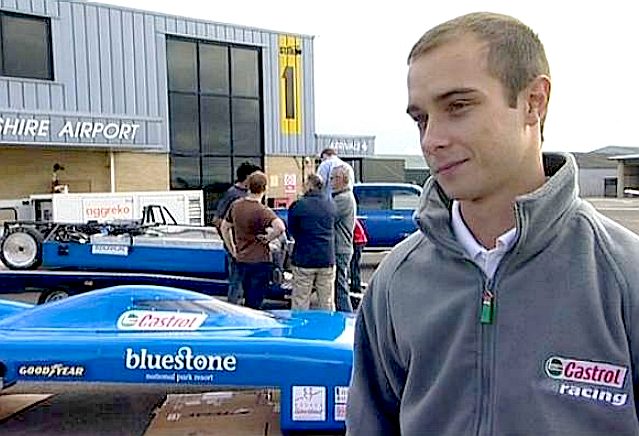
Driver Joe Wales is
interviewed by the BBC
JOE
WALES - CV
Joseph
Wales is popularly known as Joe Wales. Joe
Wales was educated at Salesian School Chertsey from 2003 until 2010
and Bournemouth University (business studies to include financial
analysis, market research and consumer trends) where he achieved a Bachelor of Arts
(BA) degree.
Joe
has been a marketing intern at Rolls-Royce Motor Cars and a senior track marshal at Daytona Motorsport.
While at Rolls Royce he was involved in the production of CGI imagery. His
biggest project was the creation of the new Rolls-Royce Wraith within their:
'configurator.' The project involved managing the production of imagery from agencies based in Munich,
to satisfy the requirements of product managers and designers.
THE
FUTURE
Joe's
dream is for a career in marketing. Motorsport is his big passion, not
unnaturally given his father's various attempts. He was one of the drivers of the
electric 'Bluebird' racing team when he had hopes of breaking both U.K and World
Speed Records, limited at the moment to electrically powered cars. He is
though only 22 (@2014), so there is plenty of time to think about the
world water speed record, or maybe a
rocket
car, like the one his great uncle
was developing before he died.
Joe Wales supports: 1. Amnesty International, 2. The Hub Bournemouth University,
and 3. Movember.
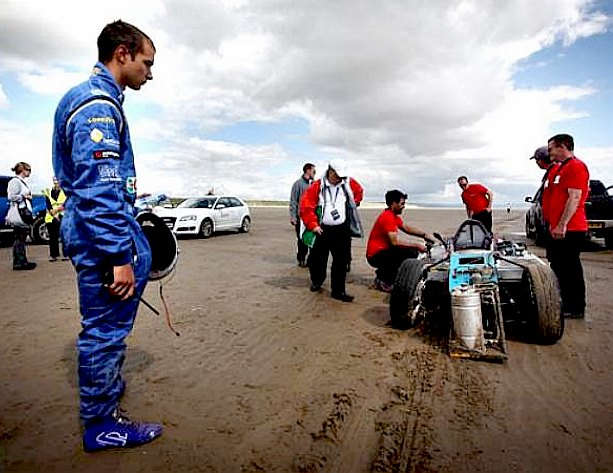
Telegraph picture of the
day 15 August 2011 - Driver Joe Wales (L) looks at the Bluebird car after it veered off course and crashed during an attempt on the British electric land speed record on Pendine Sands in Wales. The driver was unhurt. Joe and his father, Don Wales, come from a famous family who have been setting land and water speed records since 1924. He is the grandson of Sir Malcolm Campbell and nephew of Donald Campbell. Don
held the UK record of 137 miles an hour after a run at Pendine Sands in
2000, that record was broken by Ecotricity's converted Lotus in 2012, and
then again by Lord
Drayson's McLaren in 2013. These are only British LS records. The
outright LS record for EVs is held by the Buckeye
Bullet in the USA
WHAT
THE PAPERS SAID IN 2011
Team Bluebird have had a hugely disappointing weekend in August 2011. Don Wales
and his son Joe were attempting to break the 137mph speed record set at Pendine Sands in
the late 1990s, in preparation for a 2013 world record attempt. In typical
Campbell fashion they were dogged by inclement weather and a real canine invading the course on
Saturday. Their bad luck continued when 19 year old Joe called it a day after
a second run of the electric car on Sunday.
The first run was not recorded due to being too far from the measuring lasers,
then on the second run he hit a patch of soft sand on the return leg,
apparently damaging a steering rod and making the car unfit to race. What
no spares?
Thankfully
Joe was unhurt, and the family are on record as vowing to return to "the Welsh beach where their family have created history many times before."
Despite the bad luck, the car itself seemed to have been very much on song
according to James, one of the technicians from Bristol University who prepared the vehicle’s
drive-train.

E MOTORSPORT NEWS AUGUST 2011
Team Bluebird have had a hugely disappointing weekend. Don Wales (grandson of speed legend Sir Malcolm Campbell) and his son Joe were attempting to break their 137mph electric car speed record at Pendine Sands in preparation for a 2013 world record. Stifled by inclement weather and a
dog invading the course on Saturday, their bad luck continued when 19 year old Joe called it a day after the second run of the car on Sunday.
The first was unfortunately not recorded due to being too far from the measuring lasers, and then he hit a patch of deep sand on the return leg, breaking a steering rod and rendering the car un-raceable. Thankfully he was unhurt, and the family vow to return to the Welsh beach where their family have created history many times before.
Despite the bad luck, the car itself seemed to have been very much on song. I caught up with James, one of the technicians from
Bristol University who prepared the vehicle’s drivetrain, to see what made it tick. Or whine, as it turns out.
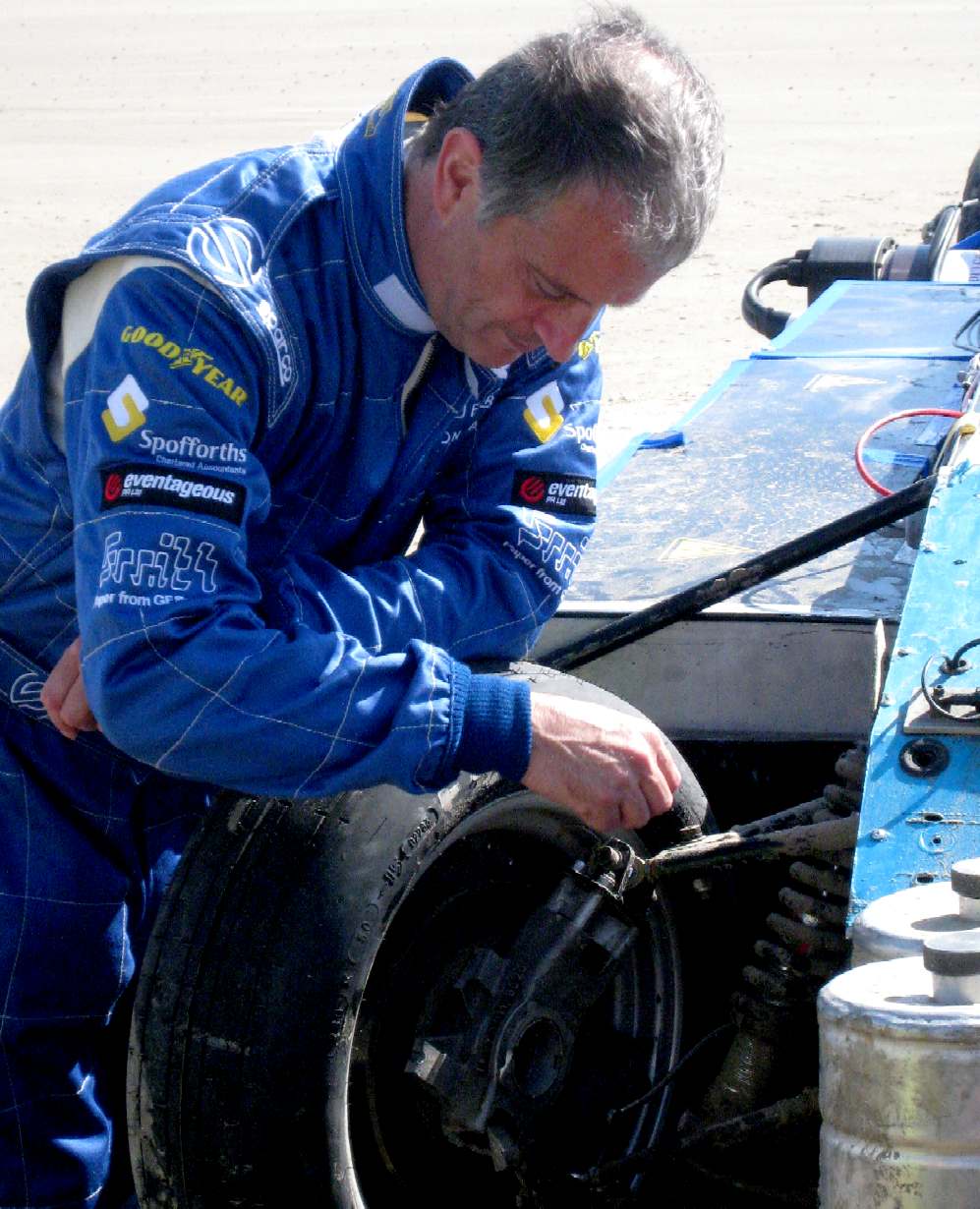
Joe's father Don
Wales, inspects the damaged front wheel and suspension. "I
should have given him some driving lessons." Don is a wedding
photographer by trade. His wife, Francesca,
(Joe's mother) is a beauty therapist.
BATTERY
POWER
When James told E Motorsport News what the cell chemistry was, it took
them back to halcyon days of tinkering with R/C models. Despite the world using lithium like it could cure baldness, the team opted for nickel cadmium (NiCad) cells;
James explained:
“The good thing about NiCad cells is that they are very robust so you can be quite abusive to them without worrying. We’re drawing up to 800 amps out of the pack, and lithium cells would literally catch fire with that level of current. They are actually aircraft starter batteries, so they are used to being abused.”
Another benefit of the NiCad chemistry is the discharge curve is very flat after 80% – until you get to 20% charge where it falls off a cliff. Unfortunately this was a problem
in 2011 where the inverters cut out because there wasn’t enough current left, leaving the car dribbling to a halt on the return run.
Much as his father's converted Formula Ford had done in 1998.
The cell pack itself is made up of 296 individual cells, giving a capacity of 45 amp hours at around 300
volts to give a 13.5 kW/hr pack. Bristol University only had 8 weeks to get the whole drive train together, so have erred on side of caution with maybe a little too much energy on board. Better to finish the quarter mile and back than stop in the middle!
The batteries are not cooled; they get warm during the charge cycle but apparently during discharge there is enough thermal inertia in the pack to keep them within operating range. And there are no ultracaps weighing it down, the juice goes straight from the cells to the controllers.
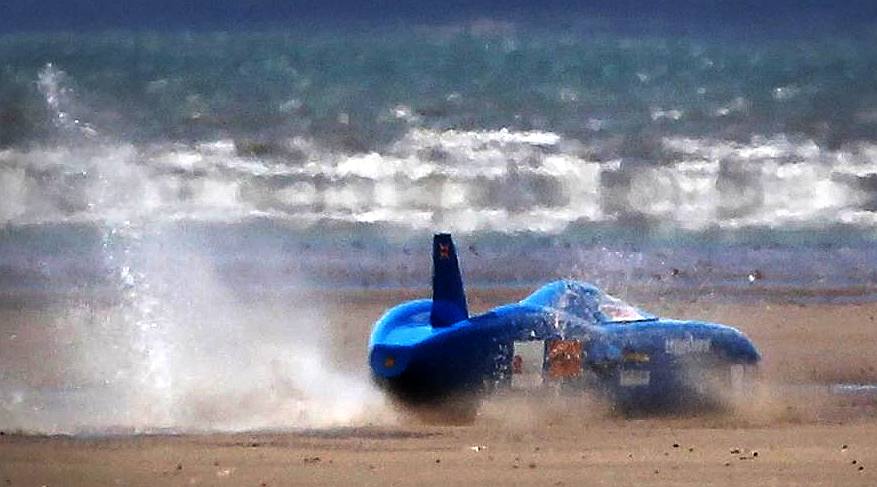
Joe veers off course
in the Bluebird car that Bristol University helped prepare, whisking up
sand and seawater as he hit soft spots in the sand (potholes), that
eventually snapped a suspension upright.
REGEN
To enable them to use a smaller battery pack and reduce charge time they
were trying to recover as much of the energy as possible. This came in the form of regenerative braking at the back with standard discs at the front. Kinetic energy is recovered during the coast down period at the end – every Watt is precious when it comes to electric motorsport.
Was Joe pleased with the car’s performance? Joe Wales is quoted as
saying that he " really felt the power and was even slightly awestruck by
it." "Despite the events of today I have been really impressed, especially when we tested it at Filton airport. Seeing it fly past at 100mph and leaving the chase car in the dust is incredible."
Until new sponsors can be found to repair the car and stage another event, the Bluebird will sing no
more, though the Wales' boys could have welded it up themselves. It seemed
though, as if they were looking for a major (German) manufacturer about to launch a range of electric cars that
might benefit from the PR if they got involved.
NOTE: There were no takers, and that was probably because manufacturing
engineers would have seen straight away that the car was uncompetitive.
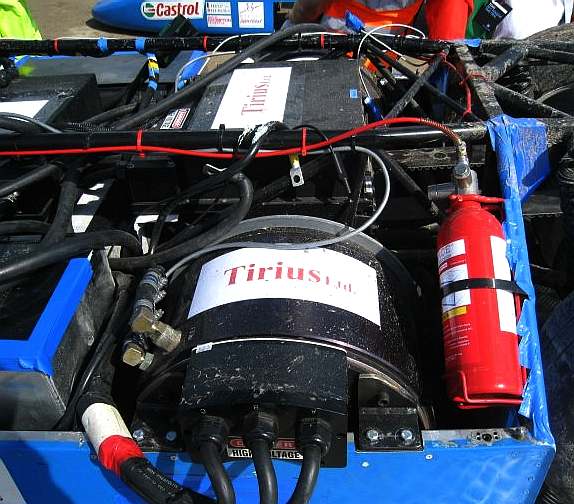
Tirius Limited:
Asynchronous DC motors fitted to the electric Bluebird for 130kW
continuous and 200kW for short burst of acceleration. To be competitive
today the team should be looking at 400kW minimum. Other LSR vehicles are
already quoting 500kW. Each
asynchronous DC motors is rated at 65kW of continuous power and peak power of 100kW. This is especially useful for this quick, high-drain application where the extra boost can be applied for up to 90 secs before
the motors start to cook. Peak torque is about 950Nm per motor and this is fed to the wheels through two very sturdy looking Kevlar belts and a 3 to 1 reduction drive.
Tirius, is a UK retrofit electric automotive company working in close partnership with the University of Bristol. Simple tap water is pumped through the drive system to keep it cool, as an air cooled design would get too hot.
TECHNICAL
This rather ageing car is driven by a pair of asynchronous DC motors rated
at 65kW continuous, and peak power of 100kW. Peak torque is about 950Nm per motor,
fed to the wheels through two Kevlar belts and a 3 to 1 reduction drive.
The motors and controllers were supplied by Tirius, a UK retrofit electric automotive company working in close partnership with the University of Bristol.
The motors are cooled with ordinary water and a pump.
The
batteries were also a hark back to yesteryears R/C models. Despite
everyone else using lithium this team opted for nickel cadmium (NiCad)
cells, drawing up to 800 amps out of the 296 aircraft starter batteries -
for a capacity of 45 AH @ around 300 volts, without capacitor smoothing
before the speed controllers. Regenerative braking on the rear wheels adds
slightly to the mix.
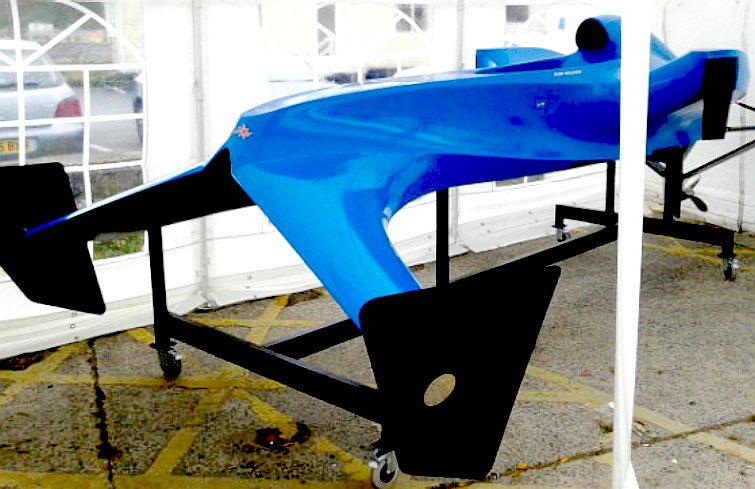
We
don't know if this electric boat is anything to do with Joe Wales, but it
is an interesting looking craft and one that we'd like to feature if
anyone might be able to help with drawings and specifications. Perhaps the
project might be due for a re-launch or re-branding. If the boat is for
sale we'd like to arrange a viewing. The current electric WWSR stands at 98.8 mph for the very compact
hydroplane built by Michael
Bontoft with which he set a new world record in October 2008 as the accompanying Youtube
shows. To put things in perspective, Sir Malcolm didn't do much better in
a Rolls Royce Merlin engined
hydroplane with 2,300 horsepower (1715Kw). It took Bontoft,
from Castle Rock, 18 months to build the boat (shown below) in his
garage, which cost him about $30,000. The lithium polymer batteries worth
$14,000 were donated by
the Korean company, Enerland Division of A123 Systems.
The boat uses a 70hp motor running at 133 volts. In February of 2009 the record was ratified by the
Union Internationale Motonautique
(UIM
record 3681), the European governing body for boat racing events. At the same time, Bontoft also set a national record with the American Power Boat Association
(APBA) at 98.252 mph.
The previous UIM and
APBA records were
50 and
70
mph respectively. That's not bad for an £18,000 boat, representing great
value for his sponsors. Michael deserves a big hand for this achievement.
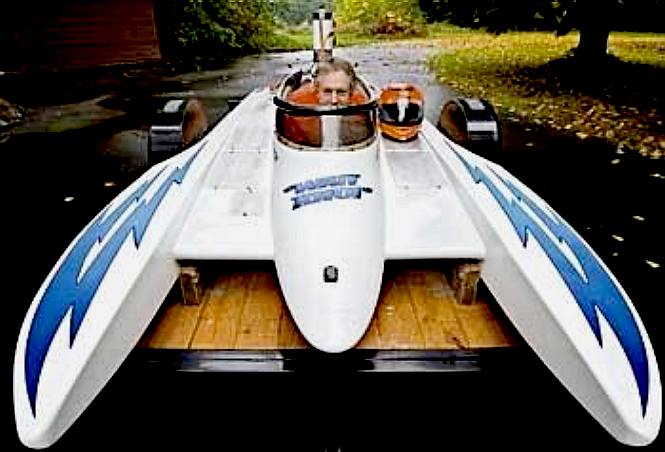
It
is estimated that it would take about 400hp (300Kw) to raise the electric
WWSR to 200 mph. A more aerodynamic form is sure to be required at those
speeds such as to contain power consumption and prevent the boat from
flipping, a phenomenon that is common to hydroplanes that go fast. Ken
Warby seems to have a handle on that problem, with his Spirit of
Australia jet boat. Any designer should perhaps start with air control
devices (as if airborne) and work backwards from a stable airframe to the water interface. A
bit like the seaplanes of old.
SPONSORSHIP
Well
then, were the team pleased with the car’s performance? Joe Wales is
quoted as saying: “That he really felt the power and was even slightly awestruck by it.”
Until new sponsors can be found to repair the car and stage another event, the Bluebird will sing no more.
With the new record set by Lord
Drayson in his electric green Lola (using lithium batteries) the bar
has been raised yet again. We don't think a repair is the answer, what
they need is a new car from an engineer with an eye for a classic line
such as Ken Norris, or the insight of John
Ackroyd and perhaps the marketing genius of Richard
Noble.
JOE'S
FATHER
Donald
Wales entered into the land speed record arena after 1991, having
agreed to drive an electric car called Bluebird 9 Electric (BE1) for the
conceptual design engineer (inventor) Nelson Kruschandl. Before that Don
was into internal combustion engines in go-karts. He was never to look
back. But maybe one day in the future he might drive a jet or rocket
powered car to contest the outright world land speed
record, like his uncle Donald Campbell. If Don and Joe had such a machine credibly on the drawing board,
sponsorship may possibly be less of a problem.
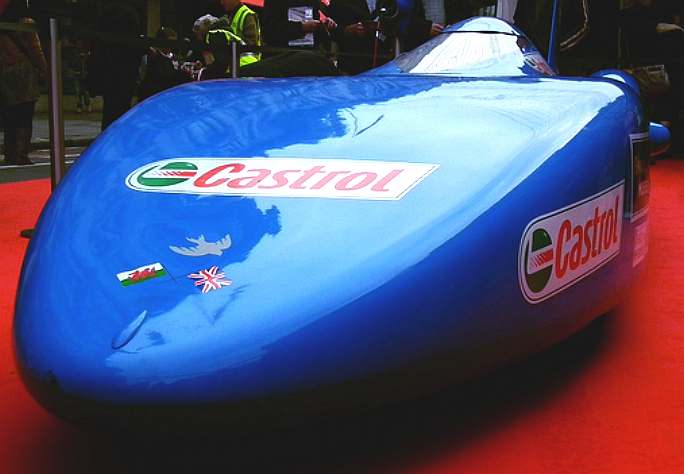
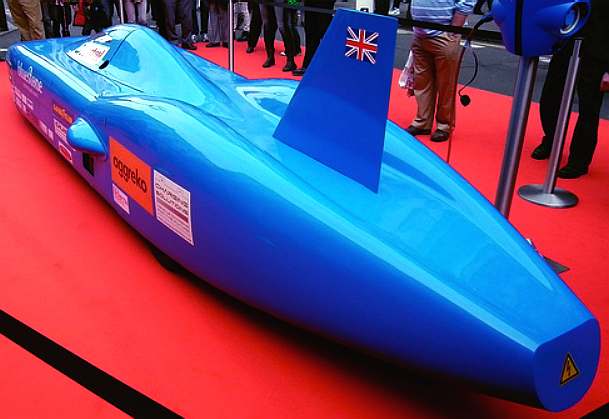
The Bluebird car that
Joe drove at Pendine
Sands, when he crashed and damaged the front
suspension, or maybe it was that the front suspension was the cause of the
crash. Some say jellyfish in the sand were to blame.
2014
ROCKINGHAM
Advertised
widely for 2014, is an event billed as one hundred years after Sir Malcolm Campbell first took to the track in a Bluebird
racecar. According to many website articles the world famous name in motor racing and speed records is returning to the racetrack with a new electric racecar design.
Sir Malcolm’s grandson, Don Wales, is now leading the charge back onto the track, following 10 years of development into pioneering the use of electric technology in racecars.
Back in the 1920s Sir Malcolm Campbell broke a number of speed records in Bluebird cars and boats before his son, Donald, continued the family tradition, achieving double world records on land and
water in 1964. Bluebird is now continuing its father and son heritage with the Bluebird Charity Trophy for Father/Sons at Rockingham.
The new unique format of fathers and sons racing together was developed by Rockingham who also decided that the event would be a great fundraiser for deserving charities. To make the Charity Race happen they have partnered with Bluebird.
With six celebrity pairings and 24 Pro-Am Father and Son teams, the charity event will help raise funds for a number of good causes.
Don Wales, Sir Malcolm Campbell’s grandson, has been the driver and Team Principal of the electric Bluebird land speed record car since its inception in the 90s.
He commented: “Electric car technology is central to everything we are doing at Bluebird and this is another opportunity to demonstrate our engineering and motorsports development. Creating the Bluebird
Trophy for fathers and sons is a great way of showcasing our advancements whilst raising funds for good causes.”
Chief Executive of Rockingham, Peter Hardman is quoted as saying:
“We are delighted to see our idea become a reality in the Bluebird Charity Trophy for Father/Sons and look forward to making significant sums for some very deserving charities. Moreover, to mark the race with the return of Bluebird to the track in what will be the first electric car race in the UK just makes it even more special for Rockingham”.
This is also a real success for Electric Corby to help bring Bluebird and electric racing to Rockingham and is another demonstration of Northamptonshire being the leading county in motorsport and high performance technologies.
The race is part of the 2014
Dunlop
MSA British Touring Car Championship at Rockingham Motor Speedway (that's the UK's Rockingham, not the one in North Carolina). Bluebird will enter an electric vehicle in a race that will feature six celebrity teams as well as two dozen father-son racing teams. The family bent makes sense, since Bluebird is named for a car Sir Malcolm Campbell, Wales' grandfather, who raced a century ago. Campbell set a number of land speed records, as did his son Donald Campbell.
Last summer, Bluebird said it was preparing to make 50 Bluebird DC50 electric sports cars that would have 360 horsepower and a 200-mile single-charge range. The company was also readying its GTL electric race car designed for the Formula E all-electric racing circuit set to debut later this year in Beijing. By last September, though, Bluebird's plans were delayed indefinitely, so this announcement is good news. Check out Bluebird's press release
below.
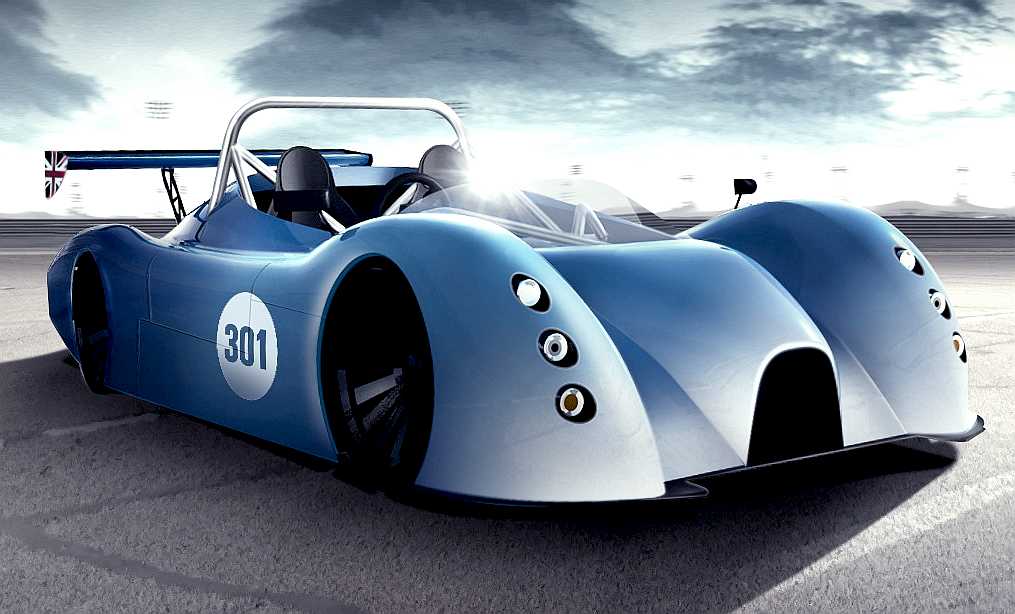
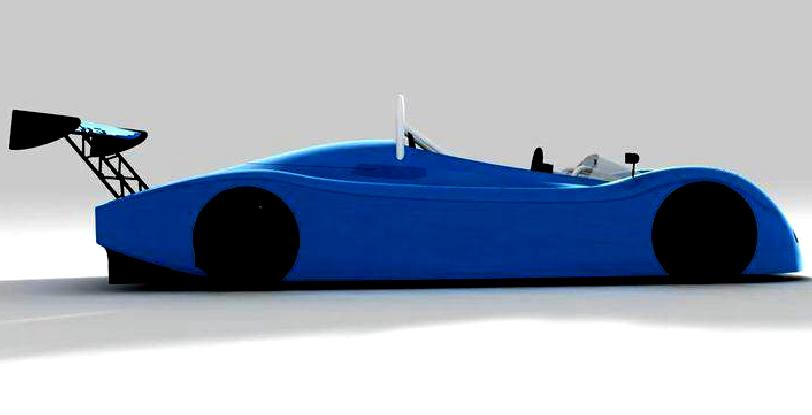
Artwork
for the proposed Rockingham Fathers & Sons, Bluebird Trophy car(s)
PRESS RELEASE: BLUEBIRD TO RETURN TO THE RACETRACK WITH PURPOSE BUILT ELECTRIC RACECAR
- New electric Bluebird car to race 100 years after Sir Malcolm Campbell first raced in a Bluebird at Brooklands
- The Bluebird Charity
Trophy for Father/Sons at Rockingham has been created to run 30 Bluebird racecars on the 6th - 7th September 2014
- Father and son format will see a mix of professional and semi-pro pairings raising money for charity
100 years after Sir Malcolm Campbell first took to the track in a Bluebird racecar, the world famous name in motor racing and speed records is returning to the racetrack with a new electric racecar design.
Sir Malcolm's grandson, Don Wales, is now leading the charge back onto the track, following 10 years of development into pioneering the use of electric technology in racecars.
Back in the 1920s Sir Malcolm Campbell broke a number of speed records in Bluebird cars and boats before his son, Donald, continued the family tradition, achieving double world records on land and water in 1964. Bluebird is now continuing its father and son heritage with the Bluebird
Charity Trophy for Father/Sons at Rockingham.
The new unique format of fathers and sons racing together was developed by Rockingham who also decided that the event would be a great fundraiser for deserving charities. To make the Charity Race happen they have partnered with Bluebird to manage the event as part of the Rockingham round of the 2014
Dunlop MSA British Touring Car Championship on 6-7th September.
With six celebrity pairings and 24 Pro-Am Father and Son teams, the charity event will help raise
funds for a number of good causes.
Don Wales, Sir Malcolm Campbell's grandson, has been the driver and Team Principal of the electric Bluebird land speed record car since its inception in the 90s.
He commented: "Electric car technology is central to everything we are doing at Bluebird and this is another opportunity to demonstrate our engineering and motorsports development. Creating the Bluebird Trophy for fathers and sons is a great way of showcasing our advancements whilst raising funds for good causes."
Peter Hardman, Chief Executive of Rockingham, said: "We are delighted to see our idea become a reality in the Bluebird Charity Trophy for Father/Sons and look forward to making significant sums for some very deserving charities. Moreover, to mark the race with the return of Bluebird to the track in what will be the first electric car race in the UK just makes it even more special for Rockingham".
This is also a real success for Electric Corby to help bring Bluebird and electric racing to
Rockingham and is another demonstration of Northamptonshire being the leading county in motorsport and high performance technologies.
Full details of the race and cars will be revealed at a launch event to be held at Rockingham in the spring.
For further updates on Bluebird please visit www.bluebirdspeed.com or follow them on Twitter @bluebirdspeed or on Facebook Bluebird Speed Records.
All driver enquiries to Rockingham Raceway: www.rockingham.co.uk
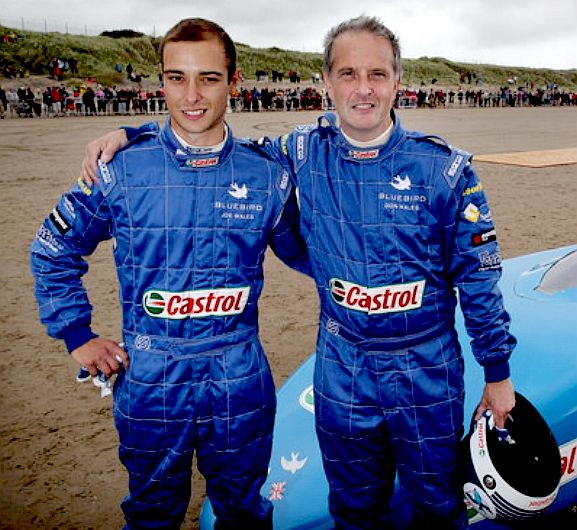
Joe and Don Wales
on Pendine Sands in 2011, the day of the fateful "jellyfish"
run. A very despondent looking Joe and his team came to update the crowds and explain what had gone wrong.
It was relayed that Pendine has too many potholes, it seems, which they
thought may be caused by jellyfish burying themselves in the sand, waiting for the tide to return.
19-year-old Joe had an excellent first run apparently and would have reached a speed of around 120 mph had he not hit potholes but unfortunately he veered off course and didn't make it through the timing lights.
The young driver injured his neck and the car broke its wishbone and would be taken to Pembroke Dock for repairs.
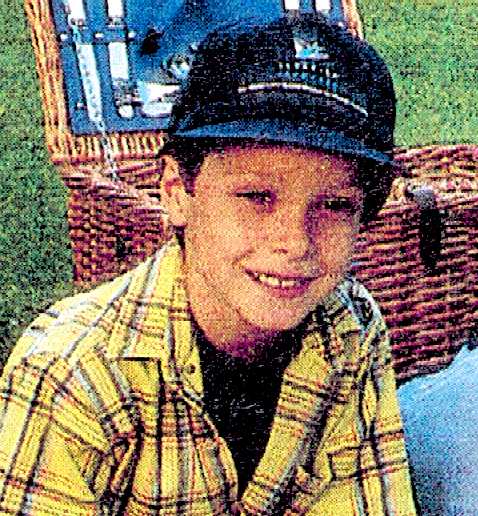
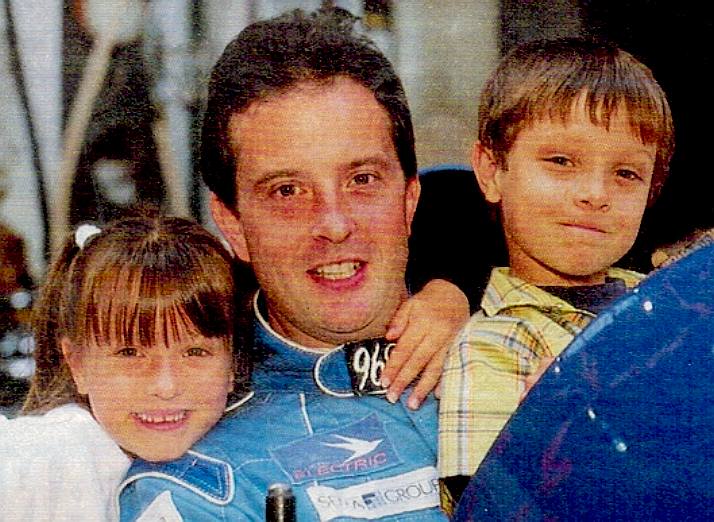
Joe is seen here on
the left picnicking during a family outing at the National
Motor Museum in 1997, making him just 5 at the time. He is wearing one
of his father's caps, bearing the multi-coloured bird symbol. On the right
Joe is sitting in his great grandfather's Sunbeam Bluebird with his dad
and sister charlotte. This car is on permanent display at Beaulieu, along
with the jet powered CN7.
History repeats itself.
ROCKINGHAM - THE BLUEBIRD TROPHY FOR FATHERS AND SONS AT ROCKINGHAM
Make history by being part of the first ever electric car race for fathers and sons.
The opportunity to team up and race the new Bluebird electric race cars to raise money for our nominated charities.
Qualification will be through pre-race events at Rockingham on 12th or 19th August 2014. The top 20 driver pairings will qualify for the final race and join 6 legendary
father and son pairings.
Final race (with practice & qualifying) at the Rockingham round of the
Dunlop MSA British Touring Car Championship on 6th and 7th September 2014.
http://www.rockingham.co.uk/bluebird/
A
BIT OF FAMILY HISTORY
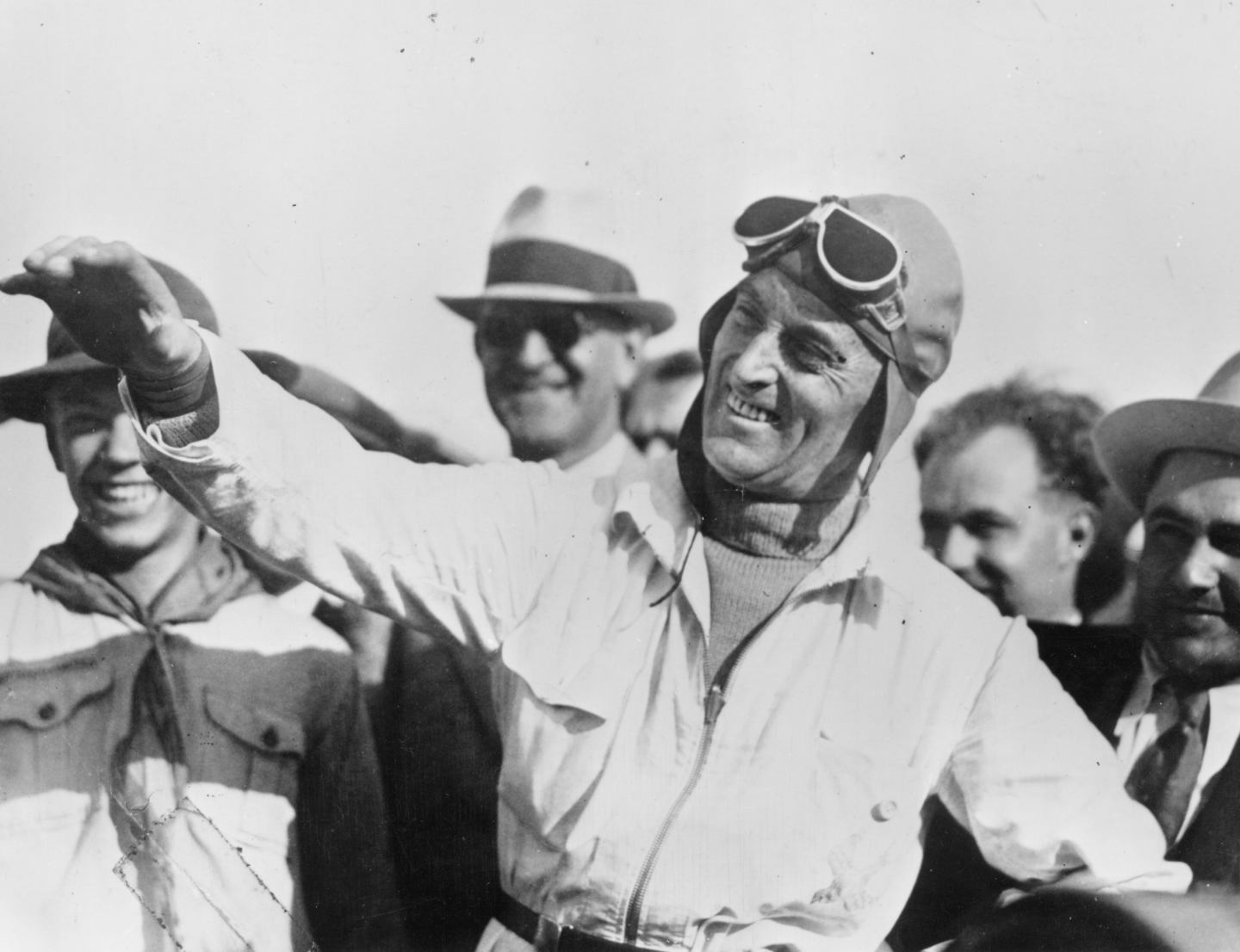
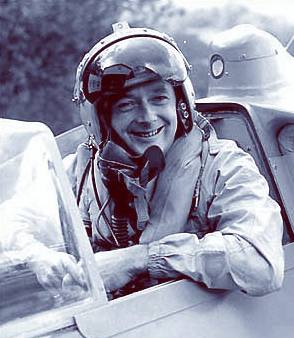
Sir Malcolm and Donald Campbell - outright speed aces
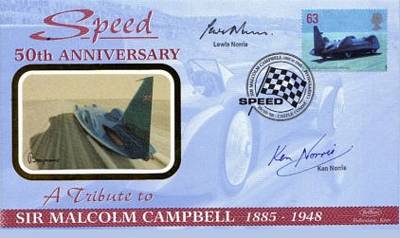
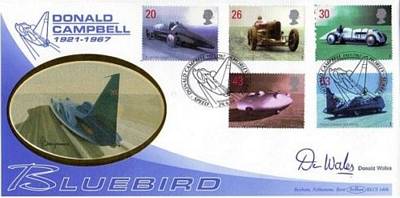
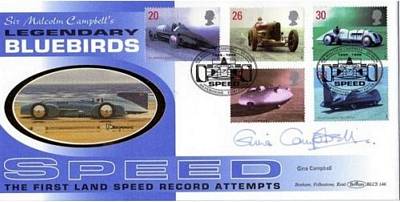
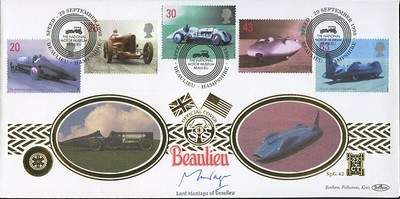

SIR
MALCOLM CAMPBELL'S BLUE BIRDS
Sunbeam
Napier
Lion
Rolls
Royce
K3
K4
DONALD
CAMPBELL'S BLUEBIRDS
K7
CN7
CNM8
JETSTAR
LINKS
& REFERENCE
BBC
blogs
wales record_attempt_foiled_by_jelly
http://www.bbc.co.uk/blogs/wales/posts/record_attempt_foiled_by_jelly
Zimbio
British Electric Car Land Speed Record Attempt Joe and Don Wales
http://www.emotorsportnews.com/technology/2011/08/what-drives-the-bluebird-land-speed-record-challenger/
http://photoblog.nbcnews.com
speed-record-for-electric-car-attempting-to-be-broken-by-the-record-setters
E
Motor
Sport News August 2011
what-drives-the-bluebird-land-speed-record-challenger
http://www.emotorsportnews.com/technology/2011/08/what-drives-the-bluebird-land-speed-record-challenger/
http://bluestoneblog.wordpress.com/2011/08/15/what-a-weekend-with-bluestone-and-bluebird-electric/
http://www.bbc.co.uk/news/uk-wales-south-west-wales-14486975
http://uk.linkedin.com/pub/joe-wales/5b/908/519
http://bluebirdelectric.com/
http://fastestlawnmower.wix.com/pb#!
http://uk.linkedin.com/pub/joe-wales/5b/908/519
http://www.gordonpoole.com/Don-Wales.aspx
http://www.donwalesphotography.co.uk/
http://www.donwalesweddings.co.uk/
Christopher
Ward - Motorsport
- Spofforths
http://www.motorsport.com/general/news/bluebird-to-return-to-the-racetrack-with-electric-race-car/
http://www.rockingham.co.uk/bluebird/
www.rockingham.co.uk
http://ev-charging.com/at/en/news/news_item/1844631
EV-Charging
- Racersdrive
http://racersdrive.com/bluebird-to-return-to-the-racetrack-with-electric-race-car/
|



















